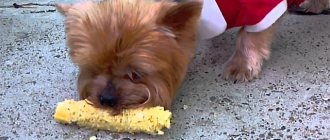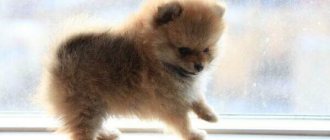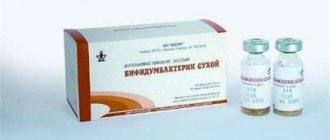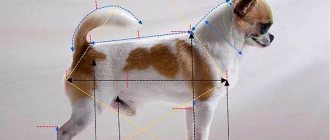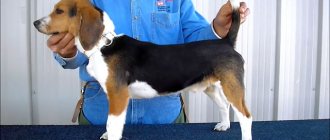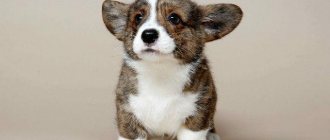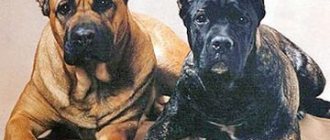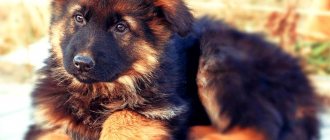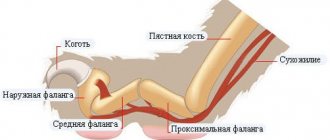Important!
If you decide to get a pet, buy a puppy only from reputable nurseries. Such establishments have been providing similar services for several years, so they have proven themselves well in the market. It doesn’t matter whether you live in Russia or abroad, carefully read reviews and listen to the advice of former clients.
Before purchasing, visit a canine exhibition, find information about the breed in printed publications, or learn the necessary information by talking directly with Yorkie owners.
Where is the best place to buy
It is recommended to purchase a dog from a breeder who has been professionally breeding representatives of this breed for many years. You can find one through the Internet or your local breed club. A serious nursery, as a rule, has its own website, where you can find out not only about the availability of available puppies, but also get acquainted with the health, character and maintenance of Yorkshire terriers. Here you can communicate directly with the breeder, as well as read reviews from the owners.
how to choose a Yorkie puppy
First vaccinations
Mother's milk protects newborn puppies from infections and diseases. When the feeding period ends, this protection disappears and is replaced by immunity developed by the puppies on their own.
Vaccinations are required to develop the immune system.
Any vaccination has several basic rules:
- It is prohibited to vaccinate a pregnant or lactating bitch;
- You should not vaccinate too early, otherwise it will not work and the risk of infection will increase;
- the same drug should be used for vaccination and revaccination;
- the puppy must be completely healthy.
CAREFULLY! Vaccinating a sick or weakened pet after an illness can cause death.
In addition, 7-10 days before vaccination it is necessary to carry out deworming, and the dog cannot be bathed a day before the procedure.
The standard vaccination schedule includes vaccinations against rabies, hepatitis, parvovirus gastroenteritis, distemper and leptospirosis.
Vaccination schedule:
- 1st vaccination – 8-9 weeks;
- revaccination – 10-11 weeks;
- 3rd vaccination – after changing teeth, approximately 7.5-8 months;
- rabies vaccination – 3-4 months and a year.
In the future, the Yorkshire Terrier must be vaccinated annually at the same time.
The owner chooses the vaccine for vaccination himself (usually Eurikan or Nobivak), and notes on the vaccinations performed are made in the veterinary passport.
A slight increase in temperature and refusal to eat after vaccination is a normal reaction of the body.
How to find out the size
To determine the size of a dog, you need to take 3 measurements using a soft measuring tape:
- Neck circumference: Measure the widest part of the neck.
- Back length: measured from withers to tail.
- Chest circumference: Measurement is taken just behind the Yorkie's front paws.
You can determine your Yorkie's clothing size using the following table:
| Neck circumference, cm | Chest circumference, cm | Back length, cm | |
| XS | 18-22 | 28-32 | 18-22 |
| S | 20-24 | 22-26 | 36-40 |
| M | 24-28 | 27-31 | 40-44 |
Important! Even if you find out the size of the dog, you still shouldn’t refuse to try it on. It is best to take your Yorkie with you to the store. This way you can choose the most suitable clothes for him.
What explains the difference in price for puppies of the same age and breed?
Yorkshire Terriers, like other dogs, are classified into three groups, each of which has its own characteristics.
Table 1. Classification of dogs according to breed standards and application.
| Name | Signs | Application |
| Show class | A puppy from champion sires with ideal breed characteristics regarding:
| Participation in exhibitions, breeding, with the opportunity to sell offspring at the highest possible price. |
| Breed-class | A dog from producers whose breed is confirmed by documents. The animal's parameters correspond to the standard, but are not as outstanding as those of the show class representatives. A prerequisite is the absence of disqualifying signs | For participation in exhibitions (without prospects for high results), breeding work. These puppies are sold at an average price. |
| Pet class | These animals do not have exhibition or breeding prospects due to minor health problems or the presence of disqualifying characteristics (non-ideal body proportions, head shape, ear size and other anatomical defects, non-standard color). | This is a pet dog that can be bought for little money. The absence of the need for a show career significantly reduces the cost of its maintenance, since there is no need to pay for participation in exhibitions. At the same time, from the point of view of an ordinary person, the dog is quite beautiful and has a set of breed characteristics. And yet such people are not allowed to do breeding work. “Defective” dogs are sold without documents. |
Adult show class dog
What is the difference between a mini Yorkie and a standard Yorkie - similarities and differences
Among dog breeders and owners there are divisions into standard and mini. Their main differences are the weight and size of the pets. The mini typically weighs from 1.6 to 2.2 kg.
But there are also differences in appearance. Mini Yorkies are called "baby faces" because of their unusual skull structure. Their muzzle is smaller, the nose is not so elongated and is more turned up. The lifespan of miniature dogs is several years shorter. The hunter's instincts are more developed in the standard breed, while the mini breeds are more timid and vulnerable.
This is interesting! The mini breed cannot bear offspring well at home, so the “baby face” is more expensive and less common.
Difference between standard and mini
In contrast to the standard
The most popular type of Yorkie is the baby face. This is a small dog with large round eyes and a short muzzle, and it certainly looks cute. Unfortunately, the appearance goes against the standard, and the dog has a number of problems related to breathing and vision. Too large eyes contribute to poor vision due to frequent conjunctivitis. Frequent diseases of the respiratory system due to the irregular anatomical structure of the skull - short and round, and the muzzle is narrow and small. Low set ears.
What makes up the price of a particular animal?
The cost of a Yorkshire Terrier, as well as other dogs, is influenced by factors such as:
- characteristics of his parents: The more titles they have, the higher the price of the offspring.
The higher the dog's characteristics, the more it is worth
You can make sure that the baby’s ancestors had exceptional breed characteristics by looking at their documents. Moreover, this must be done when deciding on the purchase of a show and breeding class animal;
- expert assessment of the puppy itself . This is due to the fact that the mating of champions can produce not only a future show ring star, but also a completely ordinary puppy. The reason is the tricks of genetics. In this case, the baby will not be a defective dog at all, but in order not to pay extra money for him, it is important to have objective information;
- assessment of the litter as a whole. High-quality and homogeneous puppies are always more expensive;
Newly born Yorkie puppies
- gender of the pet. Female Yorkshire Terriers fetch higher prices than males. And not because of breed advantages, but because breeders see them as a promising source of income.
Micro Yorkies - a rare species or breed defect
We should also talk about dwarf Yorkshire terriers, which are often called super-mini or micro-Yorks. Two more common names for this type of dog are pocket or cup dogs. These nicknames were given to the animals because of their ability to fit into a bowl or pocket.
Breeders often offer to buy micro Yorkshire terriers at high prices for profit. They justify this price tag by the fact that this is a rare species, exclusive representatives of a popular breed. Of course, you can buy a pet whose weight does not reach 1-1.5 kilograms, but you need to remember - this is a breed defect!
Keeping miniature dogs is a responsible, troublesome and time-consuming task. Micro Yorkies get sick more often, are susceptible to injury, and require special care and feeding regimen. It is necessary to ensure that animals do not jump from beds, sofas and chairs, as they can injure their heads and limbs.
Dwarfism, which is inherent in these cute miniature pets, causes nervous system disorders in dogs. Because of this, they can be more aggressive, have an unstable psyche, and are more difficult to learn and train.
Health problems, which these pets also have a lot of, lead to a sharp decrease in life expectancy. Dogs do not live to be 8-9 years old.
Frequent pathologies:
When getting such a dog, you need to constantly monitor where it is so as not to accidentally step on it or get pinched by the door. It is dangerous to leave her alone with small children. They can cause harm to health and pose a threat to the life of a micro-dog.
All Super Mini Yorkshire Terriers must be spayed to prevent accidental pregnancy. Pregnancy for such dogs is a danger to health and life. With them you can forget about breeding, participation in competitions and an exhibition career.
When can gender be determined accurately?
Dogs are born with genitals, but it is quite difficult to distinguish males from females. To avoid making a mistake, it is better to wait 2-3 weeks, when sexual characteristics become quite pronounced. In adolescence (from 6 months), the difference between females and males can be determined not only by the appearance of the genitals, but also by behavior.
The easiest way to determine the sex of a puppy is after it reaches one month of age.
Growth and development
2-3 days after birth, puppies begin to crawl. At 10-15 days their eyes open, the puppies begin to respond to light, but the retina is still poorly developed.
By 18-21 days, Yorkie babies develop a fat layer, thermoregulation appears, and they begin to respond to sharp sounds.
On days 20-24, teeth begin to erupt, and by this age the puppy begins to hear.
By the month the puppies' activity increases, they leave their “playpen” and get acquainted with their surroundings.
At 8-9 months, the change of teeth ends, and the dog begins puberty. By this age, the Yorkshire Terrier reaches its maximum height, but is still developing.
In the first months of life, puppies develop as intensively as possible; it is important to monitor weight gain in order to understand that the puppy is eating correctly and is not underweight or overweight.
Yorkie puppies weight table by month:
| Age | Micro | Mini | Standard |
| Birth weight | 80 gr | 115 gr | 160 gr |
| 1 month | 230 gr | 370 gr | 595 g |
| 2 months | 370 gr | 610 gr | 940 gr |
| 3 months | 540 gr | 850 gr | 1280 gr |
| 4 months | 710 gr | 1110 gr | 1680 g |
| 5 months | 850 gr | 1300 gr | 1990 gr |
| 6 months | 940 gr | 1450 gr | 2210 gr |
| 18 months | 1140 gr | 1820 gr | 2730 gr |
As adults, standard Yorkshire terriers reach a height at the withers of 22-24 cm, mini - 16-18 cm, micro - up to 15 cm.
What to look for when choosing a puppy
So, how to buy a Yorkshire Terrier without making a mistake?
Choosing a puppy is a serious matter
Age
Competent breeders offer animals for sale no earlier than 2-3 months after their birth. This is due to the fact that babies must go through the necessary period of breastfeeding, and at the time of transfer to the owner they could feed themselves. In addition, earlier weaning them from their mother has a negative impact on the health of the bitch. Those who dream of a dog for exhibitions are recommended to purchase a puppy six months old. By this time, conclusions can be drawn about the size and other characteristics of the dog.
Documentation
At the time of transfer to the owner, the cubs must undergo the first vaccination, which means they are required to have a veterinary passport, properly executed, with the necessary records and seals.
Veterinary passport for dogs
Every pedigree dog must also have a puppy card. It contains information about the puppy's parents, gender and name. The results of the certification, which each dog undergoes in the club (kennel) 45 days after birth, are also entered there. The litter is assessed by a certified dog handler. He also documents the results, entering the characteristics of each puppy into his individual document. Among other things, the “puppy” contains information about branding.
Brand
It is performed in the form of a tattoo and must be on the body of the dog submitted for activation. The mark is made once and remains unchanged throughout life. Unscrupulous breeders may offer an unbranded dog, explaining that it was a pity to subject the baby to the procedure. In such cases, it is logical to suspect that the documents for the dog are fake and therefore have no legal force. The same thing applies if the brand is not readable. As for the tattoo procedure, it is performed with an anesthetic element, so the kids do not suffer.
Why else do you need a brand on a dog?
Parent information
Personal acquaintance with the child’s ancestors is not enough; you need to look at their documents. In order not to doubt the origin of the puppy, it is important to make sure that its mother and father are dogs of the same breed.
This will insure against the purchase of a half-breed. Of course, the presence of third-party genes does not mean at all that the dog is not suitable as a pet, but, firstly, its price will be different, and secondly, you don’t have to be afraid of surprises when putting the animal up for mating. A representative of an unspecified breed, but with “corrected” metrics, can produce offspring that resemble Bobik’s yard grandfather. And then troubles cannot be avoided.
Temperament, conformation and health
Finding yourself in the company of cute little ones, you shouldn’t give in to emotions. You should choose your puppy wisely and soberly, paying attention to:
- Baby's physique and activity . These indicators will say a lot about his temperament and health. A good and strong puppy should be robust, and not a dog with a loose constitution. When a dog is lethargic, sleepy and indifferent, this is not normal, unless he has eaten well the day before. The Yorkshire Terrier is a naturally cheerful creature, playful and active.
- Coat color. It represents a combination of black and gold colors.
The coat should be black and gold
There should be no spots, with the exception of a tuft of white hair on the chest. This is acceptable, but it goes away after the first molt. You shouldn’t trust sellers who try to “pick up” a puppy of a non-standard color, promising that when he grows up, he will become like everyone else. If the dog is silver-gray or another color outside the breed standard, he will not turn into steel gray. Only a black and gold pet will acquire the correct color by the age of one and a half years. When purchasing a puppy, you can get an idea of what it will look like by looking at its parents.
- Wool quality . Ideally, it is flowing, clean and shiny. If there are curls, they will remain for life. Such a dog has a higher risk of developing mats if the owner does not care for it well. It is worth paying attention to the thickness of the cover. When there are even small bald patches or areas of thinning hair on the body, this may indicate health problems. The same thing applies if the skin is flaky, covered with dandruff, and the hairs are dry.
- Paws. They should be even, while large limbs are a sign that the puppy will grow large.
Pay attention to the paws
When walking, movements are free and coordinated, and the contour of the upper body is even. When a puppy's back has a hump, so does an adult dog's back. Signs of lameness or stiffness indicate possible joint problems that will worsen with age.
- Nose. Its tip is a black lobe, cool and wet. If the puppy recently woke up, it may be warm. Breathing is even, without grunting, sniffling and discharge from the nostrils, forming a white coating around.
- Teeth. Healthy dog gums are juicy pink, but pale ones can indicate anemia.
Yorkie's teeth
Each jaw contains six incisor teeth and a pair of fangs. The closed teeth of Yorkies resemble scissors, but the bite can also be pincer-like, which is also acceptable. Ideally, the outer part of the lower incisors, when closing, tightly touches the inner surface of the upper ones. A dog with underbite and overbite is subject to disqualification and is not allowed to breed.
- Head. It is worth paying attention to the fontanel. It is located in the parietal part and should be closed at 3 months. The fragile constitution of the dog in combination with a disproportionately large head resembling an apple, bulging eyes and an unovergrown fontanel are signs of dwarfism (dwarfism). In some cases, this may also indicate hydrocephalus, a condition that makes the animal unviable.
- Eyes. In dogs of this breed they are dark in color, with a damp sheen, and look straight.
Yorkies have dark eyes
Sticky “tears” can mean problems with the eyelids or diseases of the mucous membranes of the eyes. Cloudy smudges are dangerous because they can be symptoms of serious infections. Yorkies have black pupils, and the iris does not have spots that would indicate illness or traumatic injury. The third eyelid is hidden, but if it is visible, it should not be massive, and also show signs of ill health.
- Ears. At the age of two months, Yorkies do not have them, but in an ideal dog they should not be too large and heavy.
At the age of two months they are not worth it to Yorkies.
The edge of the auricle is healthy, covered with hair, without crusts or areas of baldness. The outside of the ear canal is clean. If the baby shakes his head and often scratches his ears, it is possible that there is a mite or inflammation there.
- The abdomen is not swollen, the skin on it is without spots or rashes. A bulge around the navel or groin area indicates a hernia that will require surgery to correct.
- External genitalia . It is important to examine the bitch's loop for inflammation. It is identified by sticky hairs. A Yorkie boy should also be fine with this if the end of the prepuce is clean. The testes are lowered, although in small individuals this happens with a delay. In the case of absolute undescendence of the testicles into the body of the scrotum, they speak of cryptorchidism. It can be one- or two-sided, but in any case it is a disqualifying sign.
Health status
And the last important point when choosing a pet: you need to thoroughly examine the animal to make sure that there is no threat to health.
This does not mean that you cannot buy a sick puppy, but in this case you need to know exactly what is wrong with it in order to treat it correctly. Let's start with the muzzle. The teeth should be strong and white, the bite should be correct.
Similar article: Description and features of keeping a Doberman dog
The gums are light pink in color (pale gums indicate the presence of anemia). The ears of healthy animals are clean, without dirt, crusts or unpleasant odor. An unpleasant odor from the ears is the first sign of inflammatory processes. It is also worth listening to the dog's breathing.
It’s good if it is smooth and calm, and there are no wheezing, wheezing or whistling. Otherwise, it may well turn out that your pet has serious breathing problems. Next, we examine the puppy’s body. The tummy should be absolutely smooth and pink. Any stains or scratches are excluded. If you notice a small lump on the belly, your dog most likely has an inguinal hernia.
If the tummy is swollen, this indicates the presence of worms in the animal’s body or problems with the digestive system. Examine the girl’s loop; there should be no sticky hairs near it (this is a clear sign of vaginal inflammation). Take a good look at the puppy's paws. There should be no dislocations or bulges. Also pay attention to how the dog orients itself in space - it should stand firmly on the ground and have good coordination of movements.
The puppy's coat should be absolutely clean, free of dandruff. In fact, the health of an animal largely depends on the nursery where it is kept. In good nurseries, the breeder takes care of the puppies, feeds them quality food and provides proper care.
But it’s better not to deal with those kennels where the dogs are lethargic and sickly. Therefore, when choosing a future friend and family pet, contact breeders with a good reputation. Not only will they offer you healthy dogs, but they can also help further by providing advice on caring for the animal.
Small or grown up
Breeders and sellers of Yorkshire terriers offer both babies (1.5 - 2 months) and older dogs. As a rule, most people prefer to take a small puppy into their home, however, the cubs of this breed have their own characteristics.
A baby Yorkie can be compared to a small child who has just mastered the technique of walking. This creature constantly demands attention, its energy seems limitless, and its behavior is uncontrollable. Raising a puppy cannot be left to chance. He can bite, bark constantly, and chew things. In addition, the baby needs four meals a day, which means he needs to be walked quite often.
However, there are also benefits associated with keeping your pet young. The kids are unusually cute and charming, easy to train and get used to their owners. By paying due attention to raising a dog, you can get an obedient, devoted pet that brings joy and positive emotions.
For those who are not sure that they can withstand all the troubles associated with early age, the best choice would be a 6-7 month old Yorkie. During this period, you can already see the character and temperament of the dog, evaluate its final size and color. In addition, by this time the bite has been completely formed and teeth have changed. As a rule, the puppy already knows some commands and is accustomed to the litter box and walks.
Advice. It happens that adult Yorkies are also sold. In this case, it is important to find out the reason for the sale. This may be due to both the birth of a child, a change in living conditions, and the unfavorable nature of the pet.
Who to choose when buying: a boy or a girl
Before choosing the gender of your pet, it is important to decide on the purpose of purchasing the dog. Who exactly do they want to see in the house - a brave companion or a plush, affectionate toy?
Initial tips
If you want to choose a less troublesome pet, then the gender of the dog does not play a special role. It is much more important how the dog is raised. Both girls and boys can be troublesome.
Important! The character of a Yorkie is formed in childhood and partly depends on upbringing and daily routine.
Pros of a bitch
The character of a Yorkie girl is more passive and docile. They are loving and open. Compared to other breeds, Yorkshire bitches are very clean when in heat.
Cons of a bitch
If a Yorkie girl was not adopted for the purpose of breeding and producing offspring, periodic estrus can cause inconvenience for the owners.
Pros of a male dog
Males are more cheerful and curious. They are active and love to play and run. Boys easily learn to go to the toilet in a diaper and do not mark the territory of their home on the walls.
Cons of a male dog
Males have more pronounced character and hunting instincts. On the street or in the house, boys can show aggression towards strangers and even bite.
Are there Mini Yorkies?
Little York
No, there is no such division within the breed. This should be kept in mind by those who purchase older dogs with parameters that are not adequate for their age. In order to sell the dog, “breeders” begin to convince that it is a mini version of the Yorkshire terrier. In fact, dogs that are too small grow out of weak or the smallest puppies in the litter. Inconsistency of height and weight with breed standards makes it impossible to participate in exhibitions, and will also become an obstacle to using the dog in breeding work.
Content:
Prices for puppies How to evaluate a puppy Tips for the buyer How to determine the character
Description:
Of course, everyone wants to buy a dog as early as possible, but a self-respecting nursery will never sell you a puppy under the age of two months. Because a Yorkshire terrier at two months of age is just a small dog that requires a lot, a lot of attention. But the main vaccinations have not yet been done because the first vaccination is required, and after a certain period the second vaccination is a revaccination. And only after complete quarantine can the dog be taken over by a new owner.
Mostly puppies sold from the kennel are three months old. But it often happens that puppies that are already grown up are sold. Don't be afraid of it! On the contrary, you can already see what size he will be, his character will already be formed. And the breeder will tell you exactly what kind of puppy this is. He's probably already toilet trained. You can see what beautiful fur he has and what color it is.
| If you notice after purchasing a dog that their ears are not erect, do not be upset. Because during the vaccination period, puppies’ ears tend to droop. In the future, of course, they will stand, because their size is not large and their weight is not so heavy. |
There is no need to worry about the fact that the puppy does not show any special character traits at all. Because a two or three month old puppy does not yet know the feeling of fear; everything is ahead of him!
Who are Yorkshire Terriers suitable for and how to determine the character of the future pet
Dogs of this breed are more suitable for families with children, as Yorkies are active, playful and love attention.
Character Test
If you want to buy such a pet, but there are concerns about its hyperactivity, you can choose a baby with a calmer character:
You can determine this when meeting the breeder and the future pet:
- pet the dog, pick it up, and then place it next to it. Gradually moving away from the animal, observe its reaction;
- if he trotts along happily behind you, he is an active, balanced dog, but only on the condition that, out of an excess of feelings, he does not attack and bite your legs.
Make sure your puppy doesn't start behaving aggressively.
Such behavior indicates aggressive tendencies that may not go away with age;
- if he walks slowly, he may be shy and unsure, but if he runs away with his tail between his legs, he will most likely grow up to be a coward.
You can do it differently: put the baby down, move a couple of steps away from him, squat down and lightly clap your hands. An aggressive guy will try to bite, and a calm guy will run up and start sniffing his hands. The shy one will be interested, but will not come close, and the coward will remain in place or run away.
Yorkie puppies
There is another test: you need to carefully turn the dog on its back and look at the reaction. hold it in this position for up to half a minute:
- an aggressive puppy will perceive this as violence, begin to bite and try to escape;
- the calm one will begin to resist, but realizing that this is a safe game, he will lie down and wait to see what happens next;
- the shy one will submit immediately and will not kick;
- the little coward will shrink into a ball.
An aggressive dog is not very suitable as a friend, especially when there are children in the family. He is unlikely to become tame, and may show temper every time he tries to be picked up. Such a toddler is usually impatient and difficult to control - he is used to quickly getting his way, so he will often bark and bite.
Puppy behavior
This is also a very important point when choosing a puppy. Yorkshire Terrier puppies should be happy and active. If the dog is huddled in a corner and does not show any activity, it is most likely sick. Also, the Yorkie should not be aggressive: for example, if you pick him up, he should not try to bite or scratch you. These dogs are quite friendly in nature and are attached to their owner. Therefore, even when meeting, they should show curiosity, and not aggression or fear.
Many people are also interested in: who to choose - a boy or a girl Yorkshire Terrier, and how different their behavior should be? The personality of the Yorkshire Terrier does not vary much depending on gender. It is known that girls are more trainable than boys, but they go into heat several times a year.
At this time, the dog can stain your furniture with blood secretions, and if there is insufficient control, it can give birth to offspring. The Yorkie boy tends to be more active, can mark territory, and is not very trainable. But, as experience shows, it doesn’t matter at all whether you choose a boy or a girl, because if you love and care for your pet, it won’t cause you much trouble.
Appearance
The skull is flat, small in shape, proportional to the body, and the ears are triangle-shaped and stand up. The coat is glossy, straight, thick, not fluffy, shiny. On the head and muzzle - long, golden brown brighter on the sides of the head, on the tips of the ears and in the longest places on the muzzle. The fur is slightly darker at the very tip of the tail.
An interesting fact is that the Yorkie hardly sheds due to the lack of undercoat, and its hair is very similar to human hair; it falls out due to mechanical factors or disease.
Straight, developed limbs and hind legs create an angle. The animal is active, with round beady eyes.
Active, cheerful dog, without aggression. Recently, babies' tails have been docked, but over time this fades into the background and is not necessary.
An important point for males is the descending testicles into the scrotum; if a male with age remains without the main male indicator, then this is a defect of the breed - cryptorchid.
Development of puppies by month
Newborn puppies are deaf and blind. They practically do not move: they sleep most of the day, the rest of the time they eat. The dogs are completely dependent on their mother - they feed on her milk and keep warm. She takes full care of their hygiene.
In order not to frighten the dog's family, a person should not pick up newborn babies or stroke them. Communication with puppies begins when they begin to see and hear and are ready to explore the world.
Photos and videos of a newborn Yorkie:
1 month
Almost immediately after birth, Yorkies have their tails docked. By the first month of life, the wound heals. At this age (10-14 days), the dogs’ eyes are already appearing and their ears are opening. Month-old puppies tend to explore their surroundings. The owner needs to make his home as safe as possible - it’s easy for a miniature puppy to get injured.
The baby gains weight rapidly - by 4 weeks it almost triples. A one-month-old puppy stops crawling funny - he can walk, and tries to run clumsily. Becomes very active - communicates with people and brothers. He is gradually weaned from his mother's milk: he is given liquid, and then softened and solid complementary foods.
Photos and videos of Yorkie 1 month:
2 months
At this age, puppies are already completely independent from their mother and go to live in a new home. The animal is ready for upbringing and socialization: the puppy is explained the rules for walking, communicating with people, and behavior in the house. For wrongdoing they reproach, ignore, and for good behavior they reward with “yummy food” and affection.
The dog is already eating solid food. It can be smoothly transferred to a new diet, different from the food in the breeder’s house: from food to natural food or vice versa. It is important to make the transition gradually to avoid digestive upset.
Photos and videos of Yorkie 2 months:
3-6 months
The little Yorkshire terrier continues to actively explore the world, learning to coexist with people and other animals. It is important for the owner to pay attention to his socialization - at this stage the dog’s character and his habits are established. Miniature and cute Yorkies can be stubborn and wayward: only education will make them obedient and kind pets.
An important physiological change: the babies' ears begin to straighten (one of the characteristics of the breed). This process does not have clear deadlines - there is nothing to worry about if it drags on.
From about 4 months, baby teeth are replaced by permanent ones: first the front ones, then the canines and molars. Just like in humans, this process is unpleasant and painful: the puppy may become capricious, lose appetite, and fall into apathy.
Photos and videos of a 3 month old Yorkie:
Photos and videos of a 4 month old Yorkie:
6-9 months
The puppy ceases to be a “child”. Translated into human standards, he enters “adolescence” with all its problems: demonstration of willfulness, stubbornness, desire to master the whole world and get to know its inhabitants. Patience is required from the baby's owner: you cannot frighten, beat, or punish the animal. This approach will “give” a timid, aggressive, distrustful Yorkie.
But the dog is always shown that the owner is dissatisfied with his faults and pranks: the person speaks in a stern tone, refuses to play and pet him for a while. Bad behavior is also associated with puberty: Yorkie girls experience their first heat.
At this time, females are sterilized if the owner does not plan to breed. It is important not to delay the operation: delay threatens the further development of breast and ovarian cancer.
Video of Yorkie 8 months:
9-12 months
The puppy becomes an adult animal: growth slows down, weight gain slows down. He is transferred to food for adult Yorkies, and the frequency of meals is reduced strictly to 1-2 times a day.
Yorkies live, on average, up to 10-12 years. However, they are considered senior dogs from 8 years of age. At this age, the owner must change the food according to the veterinarian’s prescription and provide the dog with the necessary living conditions.
Photo of Yorkie 1 year:
Communication and interaction with the breeder
When choosing a puppy, you should pay attention to the breeder. Ideally, he should give the impression of a person who knows everything about his dogs, treats them with love and is interested in placing the puppy only in responsible hands.
The right breeder does not avoid long conversations with a potential buyer
This breeder:
- will definitely invite you to the nursery so that the potential buyer can assess the condition of the dogs and the conditions of their keeping;
- will answer questions and will not impose on puppies using unworthy techniques;
- will provide documents of the pet and its parents for review, and introduce them to at least one of them;
- will not sell a puppy under two months and will provide detailed instructions on the features of feeding, keeping and caring for the dog;
- will certainly inquire about the living conditions of the future owner, and will also clarify how capable he is of providing the dog with proper care in accordance with the characteristics and needs of the breed;
In rare cases, a breeder can dissuade you from buying a pet if he sees that the person cannot cope with its upbringing and maintenance, and also believes that the potential owner gives the impression of an irresponsible, frivolous and mentally unstable person
- will not sell a puppy for a hat of crackers, since he spent a certain amount of money on maintaining the pregnant bitch and the born litter, and is also confident in the quality of the puppies being sold;
- will certainly leave a telephone number where the owner can get advice if necessary;
- will inform that he will not abandon his pupil to the mercy of fate if, due to circumstances, the owner can no longer support him. A responsible breeder will take the dog and find new homes for it.
Weight and height of puppies
The breed characteristics do not indicate the average height of a Yorkie. On average, doggies grow to 15-22 cm at the withers. Normal weight: 1.3-3 kg. The normal weight of large individuals is 3.6-4 kg.
The standard weight for puppies varies depending on the breed type they are: dwarf, small, medium or large. The height at the withers is also ranked according to these types: mini - no more than 15 cm, medium group - 15-18 cm, large representatives - 16-22 cm.
Average indicators for the breed are in the following table.
| Age (months) | Approximate weight (kg) |
| Newborns | 0,09-0,1 |
| 1 | 0,3-0,5 |
| 2 | 0,4-0,9 |
| 3 | 0,6-1,3 |
| 4 | 0,8-1,7 |
| 5 | 1-2 |
| 6 | 1,1-2,5 |
| 7-12 | 1,3-3,4 |
The formula will help you calculate the weight of a puppy in the future: weight at 2 months (8 weeks) * 3. The resulting number is the approximate weight of the Yorkie upon reaching 1 year. To weigh a miniature dog, you can use a regular kitchen or floor scale.
Both excess weight and body weight dystrophy are harmful to Yorkies. If a young animal is already obese, the risk of injury, development of joint pathologies, and hypoglycemia increases. Common problems with “severe” Yorkies: luxating kneecaps, hip dysplasia.
Weight loss may indicate helminth infection, congenital pathologies, or hormonal diseases that inhibit development. A common cause is improper, insufficient feeding. If a one-year-old Yorkie weighs less than 1.3 kg, a veterinarian examination is required.

